Page 31 of 516
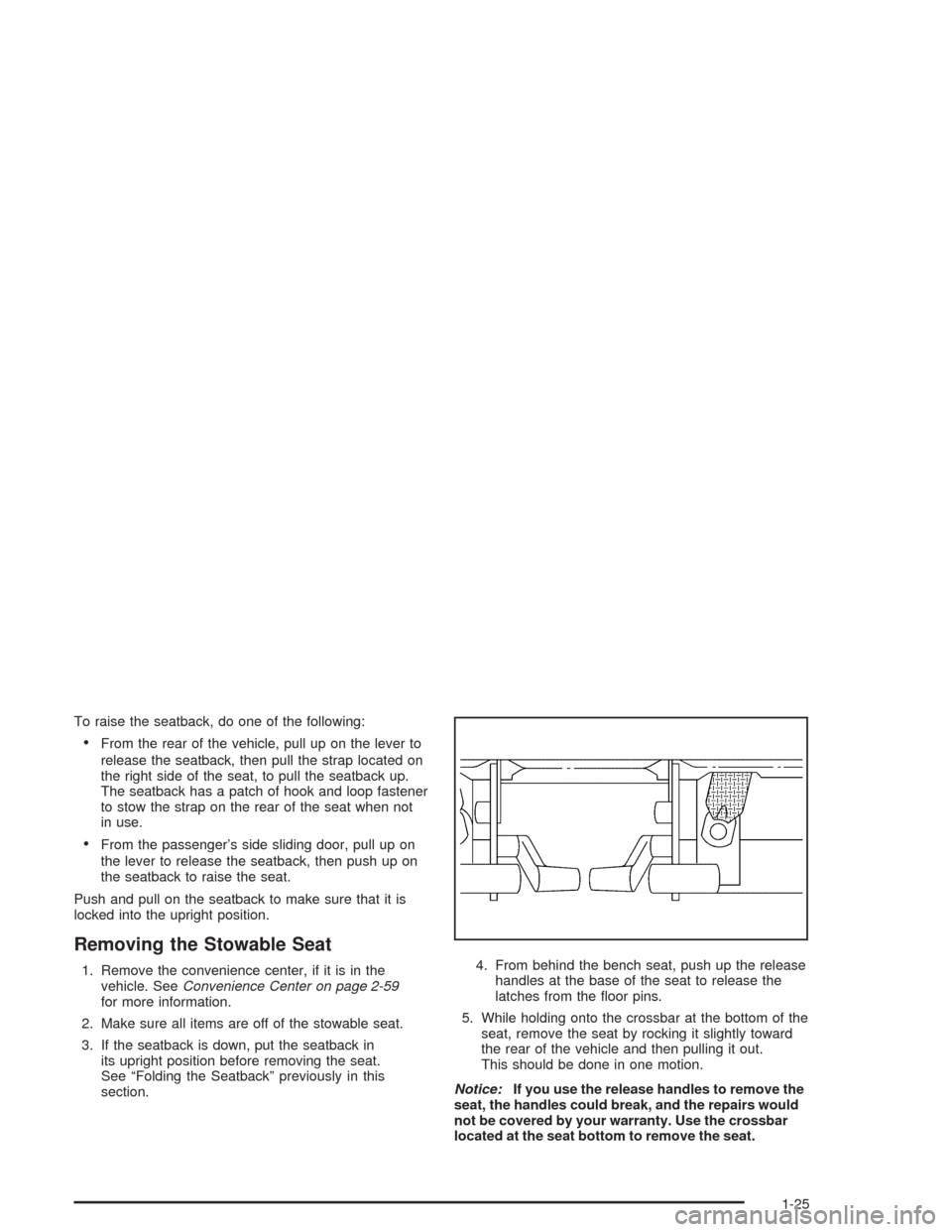
To raise the seatback, do one of the following:
From the rear of the vehicle, pull up on the lever to
release the seatback, then pull the strap located on
the right side of the seat, to pull the seatback up.
The seatback has a patch of hook and loop fastener
to stow the strap on the rear of the seat when not
in use.
From the passenger’s side sliding door, pull up on
the lever to release the seatback, then push up on
the seatback to raise the seat.
Push and pull on the seatback to make sure that it is
locked into the upright position.
Removing the Stowable Seat
1. Remove the convenience center, if it is in the
vehicle. SeeConvenience Center on page 2-59
for more information.
2. Make sure all items are off of the stowable seat.
3. If the seatback is down, put the seatback in
its upright position before removing the seat.
See “Folding the Seatback” previously in this
section.4. From behind the bench seat, push up the release
handles at the base of the seat to release the
latches from the �oor pins.
5. While holding onto the crossbar at the bottom of the
seat, remove the seat by rocking it slightly toward
the rear of the vehicle and then pulling it out.
This should be done in one motion.
Notice:If you use the release handles to remove the
seat, the handles could break, and the repairs would
not be covered by your warranty. Use the crossbar
located at the seat bottom to remove the seat.
1-25
Page 32 of 516
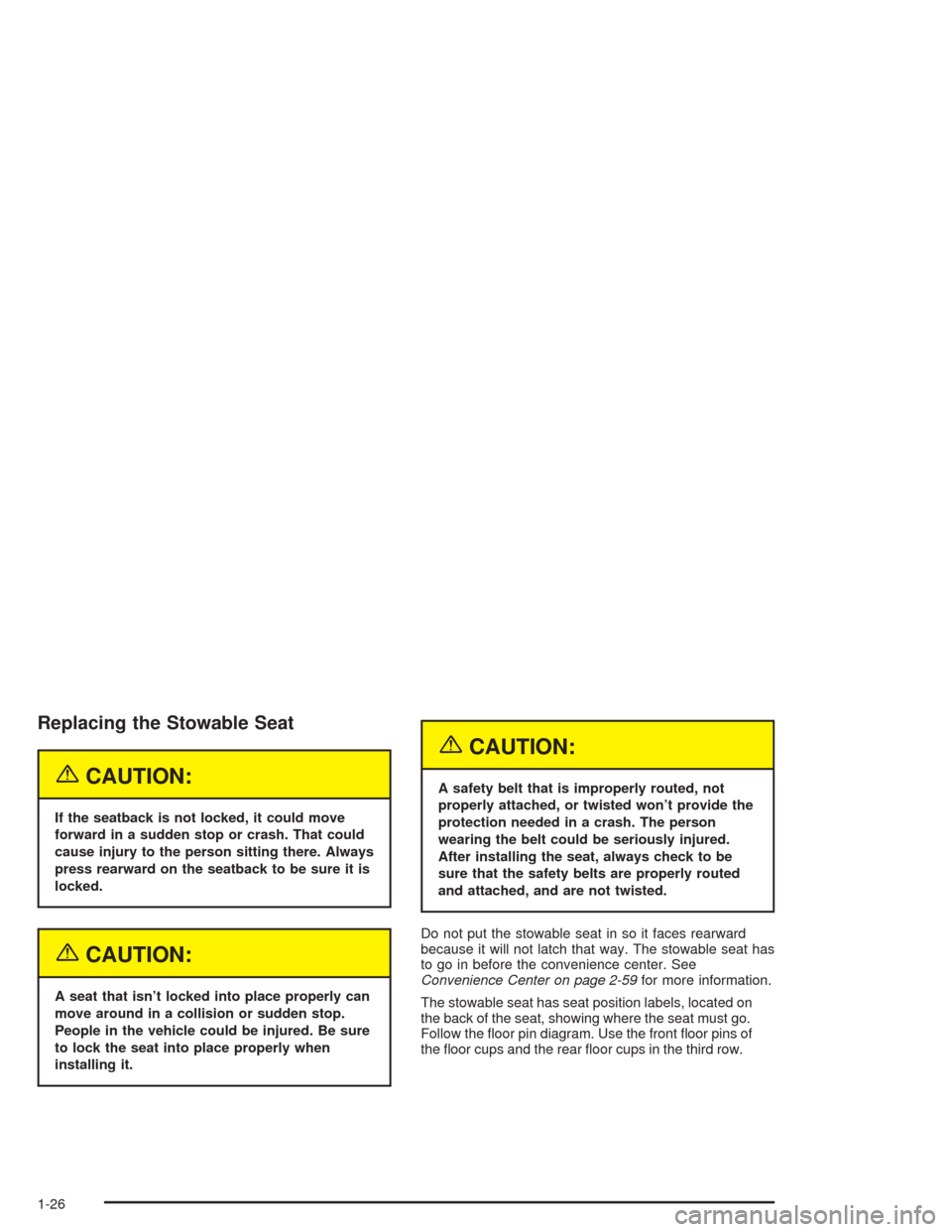
Replacing the Stowable Seat
{CAUTION:
If the seatback is not locked, it could move
forward in a sudden stop or crash. That could
cause injury to the person sitting there. Always
press rearward on the seatback to be sure it is
locked.
{CAUTION:
A seat that isn’t locked into place properly can
move around in a collision or sudden stop.
People in the vehicle could be injured. Be sure
to lock the seat into place properly when
installing it.
{CAUTION:
A safety belt that is improperly routed, not
properly attached, or twisted won’t provide the
protection needed in a crash. The person
wearing the belt could be seriously injured.
After installing the seat, always check to be
sure that the safety belts are properly routed
and attached, and are not twisted.
Do not put the stowable seat in so it faces rearward
because it will not latch that way. The stowable seat has
to go in before the convenience center. See
Convenience Center on page 2-59for more information.
The stowable seat has seat position labels, located on
the back of the seat, showing where the seat must go.
Follow the �oor pin diagram. Use the front �oor pins of
the �oor cups and the rear �oor cups in the third row.
1-26
Page 33 of 516
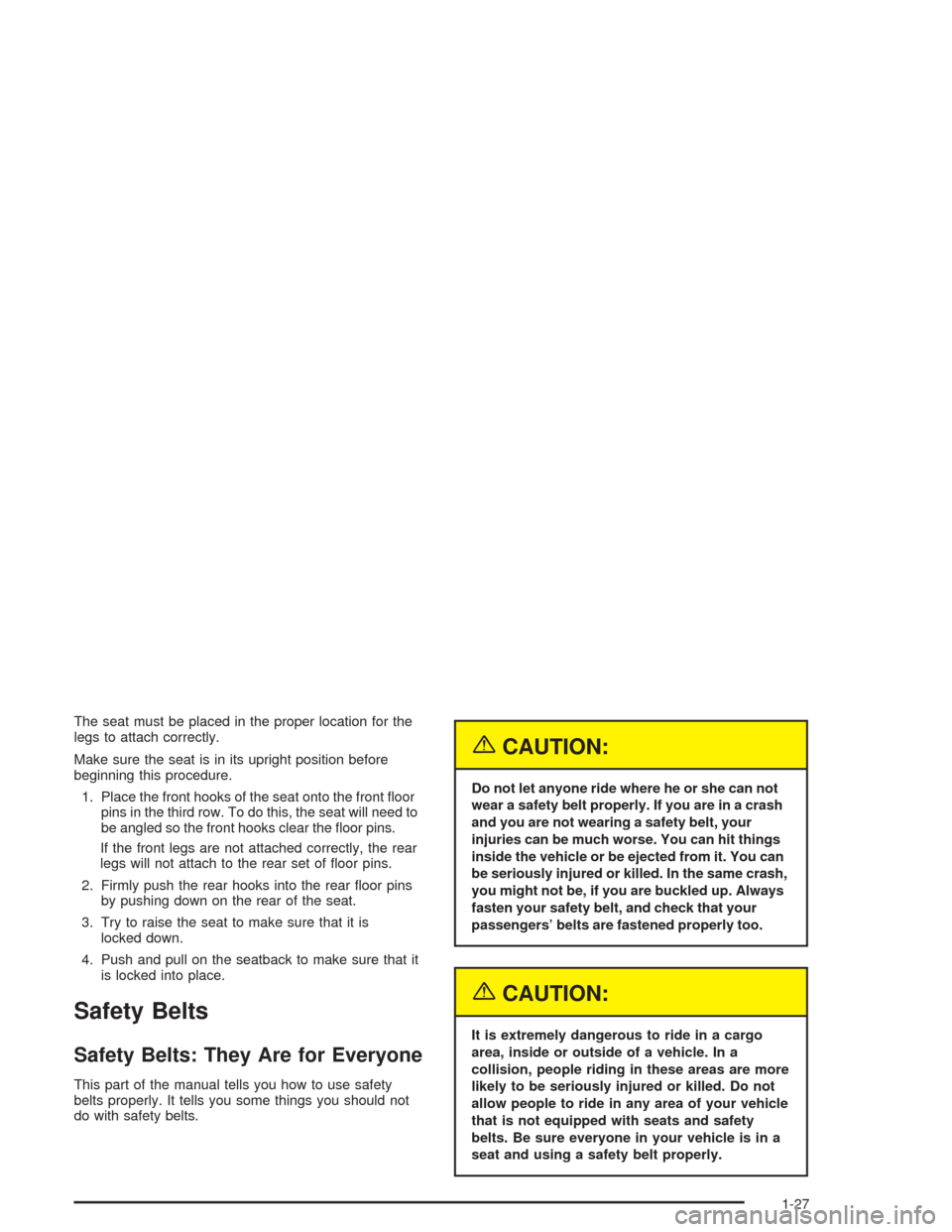
The seat must be placed in the proper location for the
legs to attach correctly.
Make sure the seat is in its upright position before
beginning this procedure.
1. Place the front hooks of the seat onto the front �oor
pins in the third row. To do this, the seat will need to
be angled so the front hooks clear the �oor pins.
If the front legs are not attached correctly, the rear
legs will not attach to the rear set of �oor pins.
2. Firmly push the rear hooks into the rear �oor pins
by pushing down on the rear of the seat.
3. Try to raise the seat to make sure that it is
locked down.
4. Push and pull on the seatback to make sure that it
is locked into place.
Safety Belts
Safety Belts: They Are for Everyone
This part of the manual tells you how to use safety
belts properly. It tells you some things you should not
do with safety belts.
{CAUTION:
Do not let anyone ride where he or she can not
wear a safety belt properly. If you are in a crash
and you are not wearing a safety belt, your
injuries can be much worse. You can hit things
inside the vehicle or be ejected from it. You can
be seriously injured or killed. In the same crash,
you might not be, if you are buckled up. Always
fasten your safety belt, and check that your
passengers’ belts are fastened properly too.
{CAUTION:
It is extremely dangerous to ride in a cargo
area, inside or outside of a vehicle. In a
collision, people riding in these areas are more
likely to be seriously injured or killed. Do not
allow people to ride in any area of your vehicle
that is not equipped with seats and safety
belts. Be sure everyone in your vehicle is in a
seat and using a safety belt properly.
1-27
Page 38 of 516
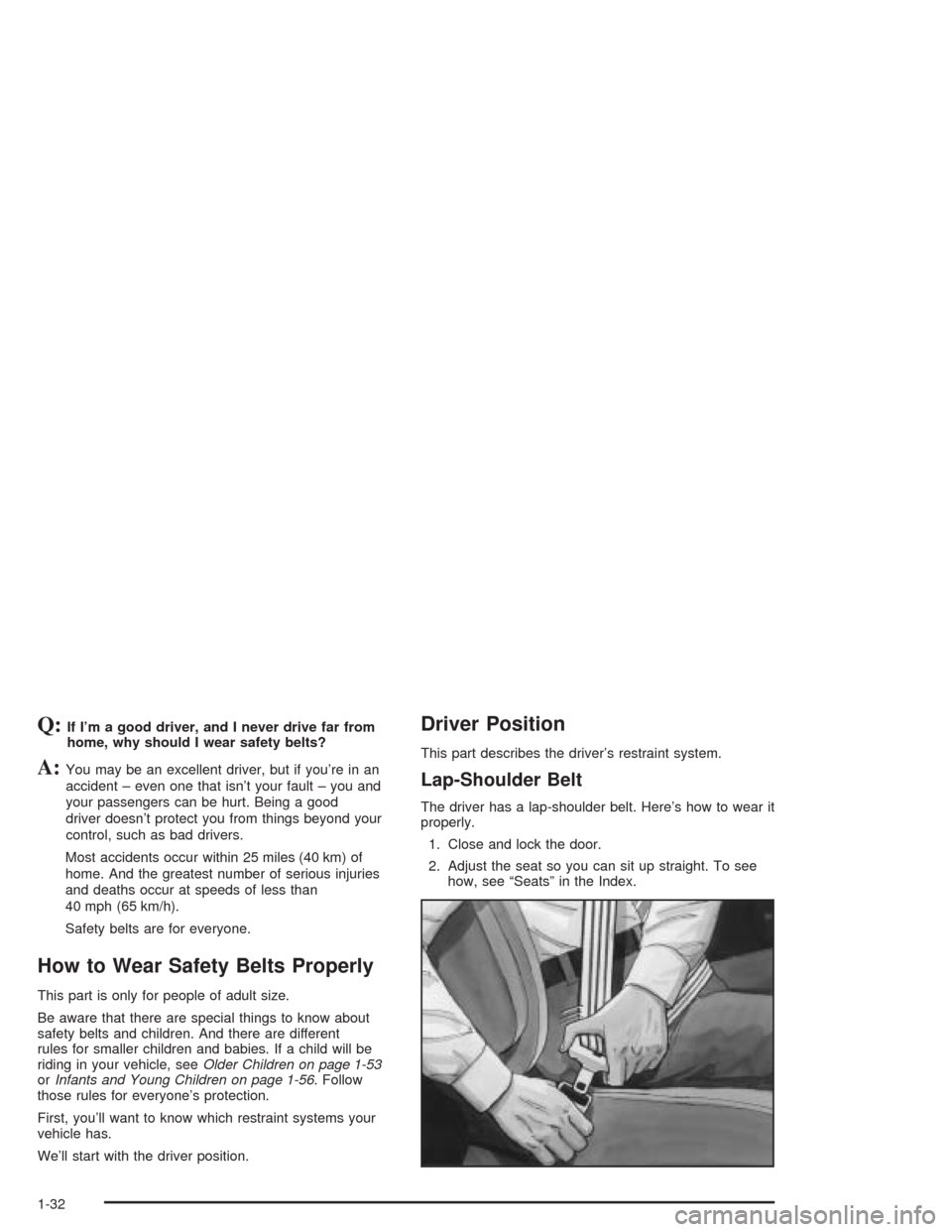
Q:If I’m a good driver, and I never drive far from
home, why should I wear safety belts?
A:You may be an excellent driver, but if you’re in an
accident – even one that isn’t your fault – you and
your passengers can be hurt. Being a good
driver doesn’t protect you from things beyond your
control, such as bad drivers.
Most accidents occur within 25 miles (40 km) of
home. And the greatest number of serious injuries
and deaths occur at speeds of less than
40 mph (65 km/h).
Safety belts are for everyone.
How to Wear Safety Belts Properly
This part is only for people of adult size.
Be aware that there are special things to know about
safety belts and children. And there are different
rules for smaller children and babies. If a child will be
riding in your vehicle, seeOlder Children on page 1-53
orInfants and Young Children on page 1-56. Follow
those rules for everyone’s protection.
First, you’ll want to know which restraint systems your
vehicle has.
We’ll start with the driver position.
Driver Position
This part describes the driver’s restraint system.
Lap-Shoulder Belt
The driver has a lap-shoulder belt. Here’s how to wear it
properly.
1. Close and lock the door.
2. Adjust the seat so you can sit up straight. To see
how, see “Seats” in the Index.
1-32
Page 39 of 516
3. Pick up the latch plate and pull the belt across you.
Don’t let it get twisted.
The shoulder belt may lock if you pull the belt
across you very quickly. If this happens, let the belt
go back slightly to unlock it. Then pull the belt
across you more slowly.
4. Push the latch plate into the buckle until it clicks.
Pull up on the latch plate to make sure it is secure.
If the belt isn’t long enough, seeSafety Belt
Extender on page 1-52.
Make sure the release button on the buckle is
positioned so you would be able to unbuckle the
safety belt quickly if you ever had to.
5. To make the lap part tight, pull down on the buckle
end of the belt as you pull up on the shoulder belt.
1-33
Page 40 of 516
The lap part of the belt should be worn low and snug on
the hips, just touching the thighs. In a crash, this
applies force to the strong pelvic bones. And you’d be
less likely to slide under the lap belt. If you slid under it,
the belt would apply force at your abdomen. This
could cause serious or even fatal injuries. The shoulder
belt should go over the shoulder and across the
chest. These parts of the body are best able to take belt
restraining forces.
The safety belt locks if there’s a sudden stop or crash,
or if you pull the belt very quickly out of the retractor.
1-34
Page 41 of 516
Shoulder Belt Height Adjuster
Before you begin to drive, move the shoulder belt
adjuster to the height that is right for you.To move it down, push down on the button and move
the height adjuster to the desired position. You can
move the adjuster up just by pushing up on the shoulder
belt guide. After you move the adjuster to where you
want it, try to move it down without pushing the button
down to make sure it has locked into position.
Adjust the height so that the shoulder portion of the belt
is centered on your shoulder. The belt should be
away from your face and neck, but not falling off your
shoulder.
1-35
Page 48 of 516
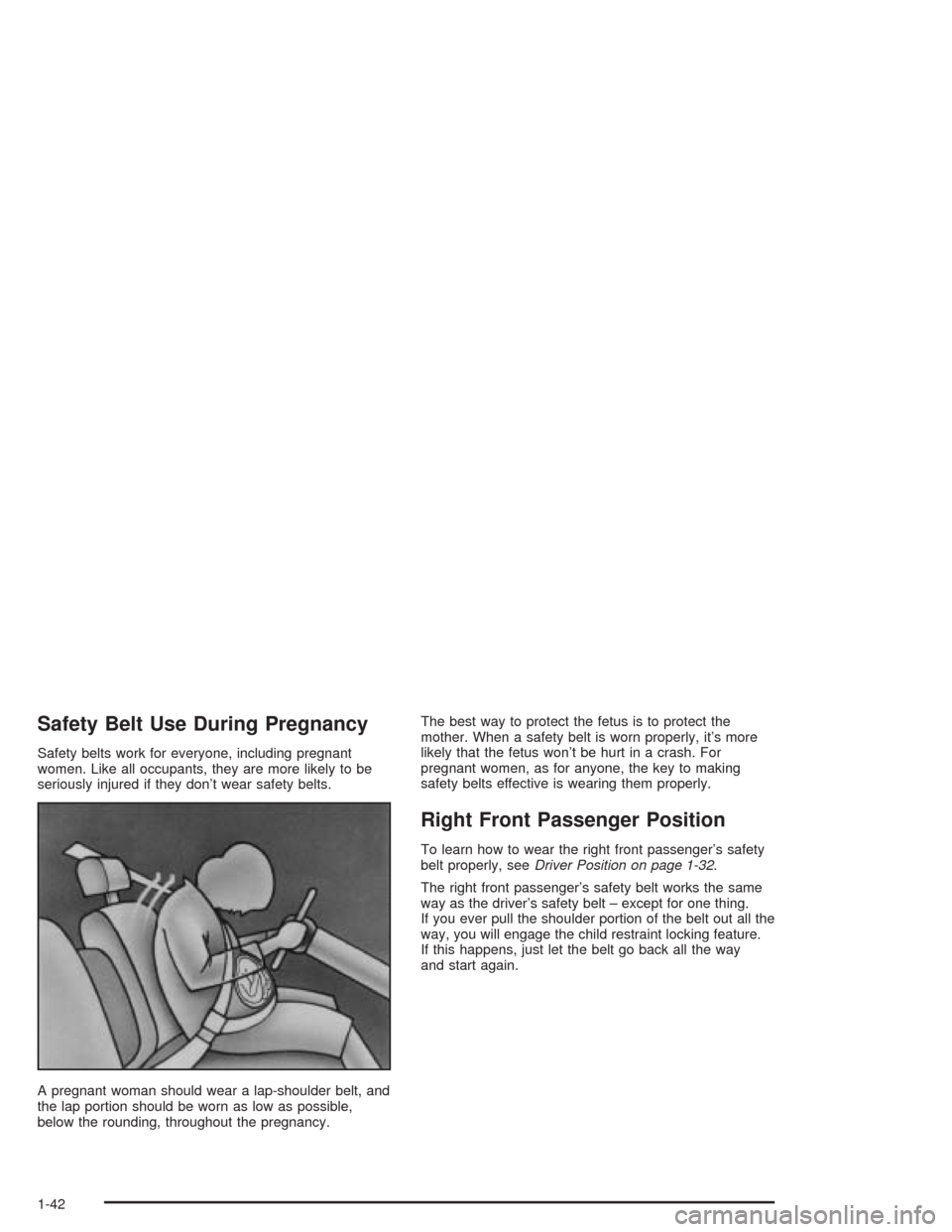
Safety Belt Use During Pregnancy
Safety belts work for everyone, including pregnant
women. Like all occupants, they are more likely to be
seriously injured if they don’t wear safety belts.
A pregnant woman should wear a lap-shoulder belt, and
the lap portion should be worn as low as possible,
below the rounding, throughout the pregnancy.The best way to protect the fetus is to protect the
mother. When a safety belt is worn properly, it’s more
likely that the fetus won’t be hurt in a crash. For
pregnant women, as for anyone, the key to making
safety belts effective is wearing them properly.
Right Front Passenger Position
To learn how to wear the right front passenger’s safety
belt properly, seeDriver Position on page 1-32.
The right front passenger’s safety belt works the same
way as the driver’s safety belt – except for one thing.
If you ever pull the shoulder portion of the belt out all the
way, you will engage the child restraint locking feature.
If this happens, just let the belt go back all the way
and start again.
1-42